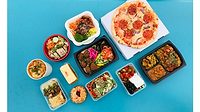Market Research
Frozen Bakery Products to Emerge as Convenient Food Options in the 21st Century

Photo by Castorly Stock
The growing demand among consumers for healthier food choices goes hand-in-hand with their increasing sedentary lifestyle. People are more inclined toward frozen food consumption owing to the convenience they have to offer, variety, freshness and easy storage. According to the American Frozen Food Institute (AFFI), nearly 70% of Americans increased their frozen food purchases during the pandemic in 2020, as frozen meals emerged as a source of comfort for the masses.
With the renewed popularity of frozen food, an inherent sector of the frozen food business—the frozen bakery market, has also gained massive traction of late. Frozen bakery products are being developed in parallel with the technological progress in the bakery sector and enable help businesses and consumers to gain access to delicious, easy-to-prepare products, like frozen bread.
Frozen bread: A Convenient Solution for Bread Wastage
It would be crucial to note that bread is one of the most wasted food products worldwide. As per reliable estimates, nearly 900,000 tons of bread is wasted every year—that’s around 24 million slices almost every day. With food waste contributing to the reduction in GDP, freezing has emerged as a viable solution for supermarkets and retailers. At a time when wheat prices are skyrocketing, frozen food production is projected to reduce crop waste. With frozen bread, bakery product distributors now find it even easier to distribute, preserve and finish the bread products.
In 2018, Love Food Hate Waste, a UK anti-waste charity, in response to the burgeoning bread wastage, introduced a new campaign urging consumers to freeze bread and consume it as a snack at any time during the day.
Recently, Flowers Foods Inc. announced a novel addition to its Canyon Bakehouse frozen line with the launch of gluten-free Hawaiian Sweet Bread and Sub Rolls. As per reports, the frozen bread products will feature Canyon Bakehouse’s advanced packaging which highlights a streamlined layout with a larger call-out to "Gluten-Free" built into the logo, making it relatively easier and convenient for shoppers to identify the brand’s gluten-free food items.
One of the key advantages of frozen bread is that it does not lose any of its qualities when baked, which is why it can be served fresh to consumers. Frozen bread dough helps reduce losses caused by the aging of products and helps keep up with the increasing demand for bread-based bakery products.
Frozen Baked Products to Help HORECA Companies in Boosting Food Service
Food service is currently one of the flourishing verticals of the hospitality industry and represents a critical proportion of the U.S. economy. Across the U.S., the restaurant industry accounts for $800 billion in valuation with the average household spending about 50% of its meal budget in restaurants. Hotels, restaurants and catering companies are now looking forward to enhancing their food services—supported by the growing sales and consumption of frozen baked products.
Used by five-star hotels and premium-class restaurants, frozen bakery goods deliver merits like the reduced need for dough containers, reduced cooking failures and no-mess kitchens, giving these places an A-grade reputation. Baked goods producers are now increasing their production capacities to satisfy the growing demand of several HORECA companies. In March 2022, Wonder Bakery, an industrial-grade bakery firm, announced its plans of establishing a 62,000-sq.-ft. production and distribution facility at the Dubai Industrial City under an investment of $14 million.
As per sources, the newly developed unit would produce up to 50,000 tons of frozen bakery products that would be distributed to restaurants, hotels and other food and beverage businesses in the UAE and other regions.
What Makes Ready-To-Bake Frozen Baked Products Highly Preferable Among the Gen Z Population?
The frozen bakery industry is anticipated to be majorly influenced by the demand and desires of the Gen Z consumer population, given the convenience these food options deliver. As per a reliable estimate, Gen Z is 30% more likely to consume frozen meals than millennials, given their hectic schedules.
Ready-to-bake products save preparation time making them ideal for this demographic, who need a responsive and quick food option. Recently, Red Lobster introduced a new product line of ready-to-bake cheddar bay biscuits. The product launch is expected to strengthen the company’s frozen food aisle.
In yet another instance, Levain unveiled ready-to-bake versions of its iconic colossal cookies at Whole Foods outlets nationwide. The company’s frozen portfolio includes chocolate-walnut, as well as variations of its dark chocolate chip and two-chip cookies.
What Does the Future Look Like for the Frozen Bakery Industry?
With more than half of the global population residing in cities and the trend of urbanization growing, the need for convenience foods is depicting an increase, which will support the expansion of the frozen bakery market in the years to come. This can be attributed to their easy portability and long shelf-life of 6 to 8 months. Regionally, the demand for frozen baked products is growing all over, especially in developing countries like China, India and others, propelled by the expanding working population and rising consumption of ready-to-eat meals.
The COVID-19 pandemic has also majorly contributed to the growth of the frozen bakery market, since as the infection spread the importance of shelf-stable and hygienic packaged foods increased. From a storage and distribution perspective, the industry is set to observe an unparalleled demand from retailers, manufacturers and consumers, particularly for pizzas, frozen bread, biscuits and cookies.Looking for a reprint of this article?
From high-res PDFs to custom plaques, order your copy today!





